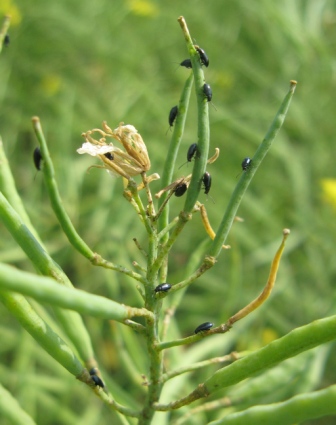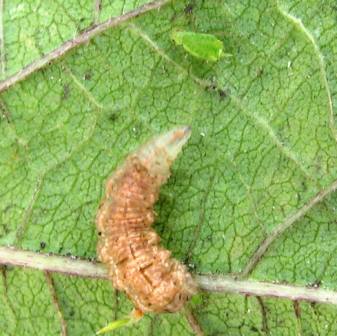Manitoba Insect and Disease Update: Week of August 19, 2013
Flea Beetles on podded canola:
While scouting or staging canola, many of you will notice that there can be what seem like fairly high levels of flea beetles on the mature canola. So here is a refresher on what we do know regarding the potential impact of these late-season flea beetles.
No specific economic thresholds are available for fall populations of flea beetles in canola, although research to try to develop some has been done at AAFC in Saskatoon. The researchers concluded that except in situations where there are extremely high populations (100’s per plant on average) feeding on plants in the very early podding stages, these populations are not likely to be economical. The biggest concern with the feeding on plants in the early-podding stage is potential increases in pod shattering and loss of seed.
Spraying for flea beetles in the fall for the purpose of reducing the risk the following spring is not recommended. Flea beetles are mobile enough that you could still have problems in the spring, as they move in from neighboring areas. In addition, there can be big differences between fall and spring populations. A strong correlation between fall and spring populations has never been established.

Anyone growing cruciferous vegetable crops will need to monitor flea beetle levels. As the canola matures and is swathed the flea beetles will move to other cruciferous plants to feed. Some have noticed the flea beetles on crops next to their swathed canola and wondered if they will feed on them. The crucifer flea beetle (Phyllotreta cruciferae) and striped flea beetle (Phyllotreta striolata), which are the 2 most abundant species in canola, are crucifer specialists. So they will feed on cruciferous plants (canola, mustard, cabbage, cruciferous weeds and flowers, etc). But they will not feed on grain crops, sunflowers, or other crops outside the crucifer family of plants.
Grasshopper Survey:
A reminder to those involved in the grasshopper survey, that counts are generally done during August, when the majority of grasshoppers are in the adult stage. Agronomists and farmers who would also be interested in estimating grasshopper numbers in the fields they are in and have this information included in the survey are encouraged to see the survey protocol for more details of the survey and where to send data. Estimates of grasshopper levels can be collected during regular field visits. The grasshopper survey protocol is located at: Province of Manitoba | agriculture - Manitoba Grasshopper Survey Protocol (gov.mb.ca)
Insect Identification Quiz
Question: You will often see these legless, "slug-like" larvae when examining the leaves of plants or the heads of grains. What are they? When on the heads of grain crops, will they feed on the grain?
Hint 1 - the green insect at the top of the picture is an aphid that was likely devoured soon after this photo was taken.
Hint 2 - The adult stage of this insect is a fly, that is good at hovering.

Answer: This is the larva of a hover fly. There are about 500 species of hover flies in Canada. Larvae from different species can be different colours; brown or green seems to be the most common. They will feed on small caterpillars as well as aphids. A single larva can consume up to 400 aphids during its development, depending on the species of hover fly and aphid.
Compiled by:
- John Gavloski, Entomologist
Manitoba Agriculture, Food and Rural Initiatives
Phone: (204) 745-5668
Fax: (204) 745-5690.
- Holly Derksen, Plant Pathologist
Manitoba Agriculture, Food and Rural Initiatives
Phone: (204) 750-4248
Fax: (204) 745-5690
To report observations on insects or plant pathogens that may be of interest or importance to farmers and agronomists in Manitoba, please send messages to the above contact address.
To be placed on an E-mail list so you will be notified immediately when new Manitoba Insect and Disease Updates are posted, please contact John Gavloski at the address or numbers listed above.


